It’s a long ways from the mountains of Maine down the Appalachian Trail to the mountains of western North Carolina. It is also a long ways from ones 20’s to ones 60’s. These distances revealed themselves recently when I notice a plant while hiking in the Smokies.
It was familiar but not familiar, a wrong plant in the wrong place I thought. But it was the right plant in the right place, kind of. The problem was I had 40 years of fog in my memory. Helping me sort out the mystery was Doug Elliott, edible plant expert, story-teller and long-time resident of North Carolina. He and his wife Yanna were kind enough to have me and my friend Kelly over to their place in a “holler.” Besides a close up view of their homestead and a taste of sumptuous food I got to ask Doug about my mountain-top mystery. ‘Sounds like an Aronia,’ he said, ‘with the unfortunate name of chokeberry.’ He got it right. The fog began to clear.
What confounded me is that the Aronia is generally thought of as a northern plant and quite common in my native state of Maine. And while North Carolina is not balmy in the winter it’s not the deep freeze New England can be… unless one goes up. Going up 1,000 feet takes you north about 700 miles in climate and season which effects the flora and fauna. Thus the Aronia is a northern genus but it creeps down the spine of the Appalachian Mountains, thriving in the cooler higher altitudes. It was until recently a much over-looked species. In fact, if a big pharmaceutical company could invent a plant it would be the Aronia.
Much like Hawthorns botanists can’t agree on just how many Aronia there are though their numbers are dramatically far less than Hawthorns. There is a red variety, a purple variety, and a black one… maybe… and lot of commercial cultivars and a few natural hybrids and regional genetic differences. But the main point is their edible bitter berries are one of the richest sources of the stuff we — at the moment — think are good for us: Anthocyanins. They are water-soluble pigments that protect our cells from free radicals. Anthocyanins are the main reason, for example, why blueberries are blue and why they are good for us. In fact, Aronia berries have greater antioxidant activity than blueberries and cranberries (five times higher than each) and higher antioxidant activity than pomegranates, strawberries, cherries, even the vaunted goji berry. No fruit grown in a temperate climate has more antioxidants and flavonoids. Though bitter the berries can range from 12 to 20 percent sugar and per 100 fresh grams have 560 to 1059 mg of anthocyanins. It’s no wonder they are being cultivated in many states.
One species of Aronia, A. melanocarpa, has been well-investigated. It not only has anthocyanins but a host of potential positive chemicals including blue Malvidin, Caffeic Acid (an anti-oxidant also found in wine) blue Delphinidin, dark red-purple Cyanidin-3-Galactoside, and Epicatechin, an anti-oxidant found in chocolate. We may not be able to pronounce them but they are anti-… anti-bacterial, anti-viral, anti-arterial plaque, anti-cholesterol, anti-cancer, anti-flu, anti-E coli, anti-high blood sugar, anti-herpes, anti-HIV, anti-Crohn’s Disease as well as improving insulin production while protecting the liver and the stomach. No toxic effects are reported and the genus is naturally pest resistant. That’s quite a lot for a nondescript plant I saw on a mountain top.
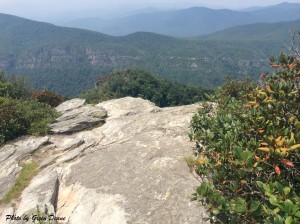
Typical environment for the Black Chokeberry in its southern range. The chokeberry is on the right. Photo by Green Deane
The common name chokeberry is self-evident. The berries are tart and bitter and it’s difficult to choke them down. But they can be made into jams, jellies, juice (by itself or blended) pies and other baked goods. They are also made into wine, stronger alcoholic beverages, pickles, flavoring for ice cream and yogurt and used as a natural food coloring. Among native Americans the Abnaki and Potawatomi ate them for food. Wildlife that live in them or eat the leaves or berries include the white-tailed deer, rabbits, ruffed grouse, sharp-tailed grouse and prairie chickens. The genus name comes from “aria” which is the Greek name for the mountain ash (Sorbus aria.) The red variety of the Aronia has red fruit similar to the red fruit of the Mountain Ash thus the base word was borrowed. Melanocarpa is also Greek meaning black fruit… So Aronia melanocarpa means by intent Red Fruit Black Fruit which is somewhat descriptive but not too inventive. Mountain Ash Black Fruit is just confusing. To get away from the name chokeberry, which people confuse with chokecherry, some have taken to calling it “Aroniaberry” but it hasn’t caught on. Some botanists also put them in the genus Photinia and that is by no means settled. Other botanical names for the Chokeberry have been Aronia arbutifolia (the red one) Aronia nigra, Photinia melanocarpa, Pyrus arbutifolia (red) Pyrus melanocarpa, and Sorbus melanocarpa. A. prunifolia and A. floribunda might be hybrids.
Here are some key identification differences between the Black Chokeberry and the Red Chokeberry:
The Black Chokeberry produces larger fruits that mature to purplish-black, while red chokeberry produces smaller fruits that mature to red;
Black Chokeberry’s fruits mature in late summer and then shrivel and drop, while red chokeberry’s fruits mature in fall and persist into winter;
Black Chokeberry is glabrous (not hairy) while red chokeberry is pubescent (hairy;)
Black Chokeberry plants tend to have a more rounded shape and remain more fully leaved to the base, while the red chokeberry is more upright and tends to be bare at the base;
The Black Chokeberry is naturally found in both wet and dry soils, while Red Chokeberry is found mostly in wet soils. On the mountain tops of North Carolina I saw only Black Chokeberries. Still confused? Know the black and red forms can hybridized. Several cultivars are also available. To be clear, while the research has been on the darker berries the red and the darker-colored berries are edible.
Green Deane’s Itemized Plant Profile
IDENTIFICATION:
Black Chokeberry: a multi-stemmed shrub, deciduous, eastern North American. Four to eight feet, can form dense colonies. Leaves alternate, 1–3 inches in length, 3/4–2 inches in width, oval but narrower at the base than near the tip, fine, regular teeth, top surface dark green, shiny with dark glands on the upper surface of the midrib. Lower surface lighter green, both sides non-hairy. Flowers have five white petals, many pink stamens. Berries 1/3 – 1/2 inch diameter, glossy and black when ripe, hang down in clusters from red pedicels, 30 or so fruits per cluster, one to five seeds each.
TIME OF YEAR:
Flowers open mid-May, fruits usually mature by August
ENVIRONMENT:
Hardy to USDA zone 3 which is to -40 degrees F. Moderately tolerant of shade, prefers moist acid soils from low wet areas to dry sandy slopes meaning bogs, swamps, low wooded areas and clearings as well as dry rocky slopes, bluffs and cliffs. Also found beside roads and power line rights of way. Tolerant of salt spray, drought and soil compaction. While the Black Chokeberry can be found in wet and dry conditions the Red Chokeberry is usually found in wet conditions and rarely in dry areas. The red variety is more tolerant of heat. The genus is found in the eastern half of the United States, New England south and west to Texas, down the Appalachian Mountains to Georgia and reportedly into north Florida. Aronias can be used in landscaping and some have brilliant fall foliage.
METHOD OF PREPARATION
Can be eaten raw but bitter. Better made into jams and jellies, juice, wine and used in baked goods.

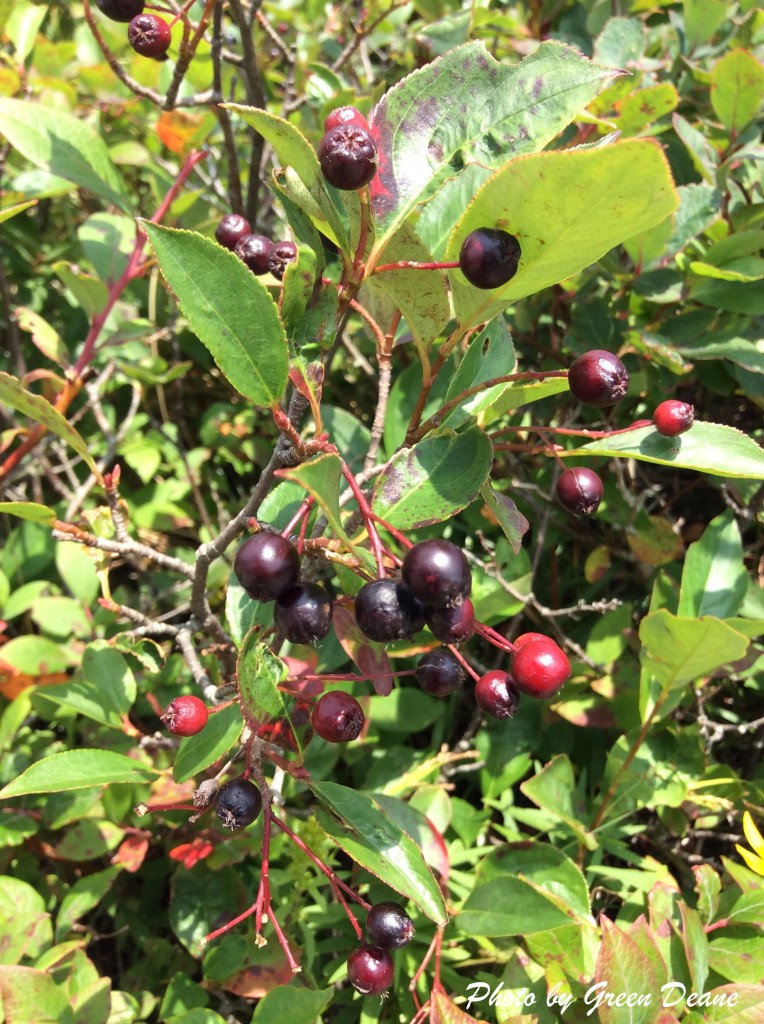
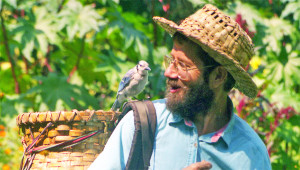
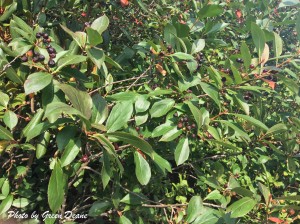
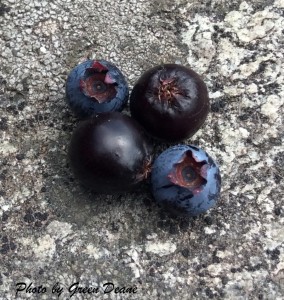
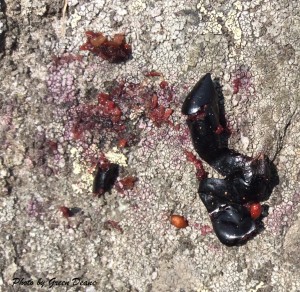
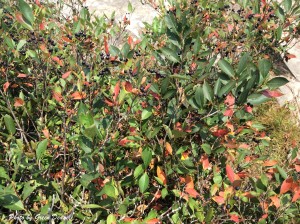

Do you have any recipes that make the berry more palatable?
We grow aronia and it is astonishingly productive. I don’t really like them by themselves, but we mix them with orange juice and add water in a blender. It makes a tropical fruit shake. IT’s extremely healthy and nutritious. You get all of the fiber and the health of the aronia, plus a purple color. A special treat for the late summer and early fall.
I have also grafted crabapples and pears onto aronia as rootstock. Pears seem to do better. I have pears growing on my aronia bush right now.
John S
PDX OR
Hi Dean,
Since reading this I’m very eager to find a chokeberry bush in my area (South Western Mass.) and today I found what looks a lot like your description, it’s more of a climbing bush (next to a telephone pole along a street) , 5 narrow leaves coming from a center point, on brilliant red stems, and strong, waxy red stems that branch 3 ways, each branch has clusters of smooth dark blue berries , but they’re not black nor are they larger than blueberries. Each has about 3 or 4 seeds. It tastes slightly sweet ( I didn’t swallow) . The colors are striking. Any guesses what it might be?
Got a picture? The Green Deane Forum has a UFO page for Unidentified Flowering Objects.
Choke berries or as I grew up calling them choke cherries make a great jelly when mixed with grapes or other berries my family has harvested them many gens just for that purpose
Finally someone named the berry as I called it choke cherry. Best eaten late fall or early winter when they are sweeter. Better yet made into a potent wine. Southern Manitoba, Canada is home to these berries as well as pin cherry cranberry (on trees not at all like the ones you see people harvesting with rubber boots in a swamp!) Gooseberry, Strawberry, Raspberry, BlackCurrant, Blueberry, Wild plum, hazelnut, morels, honey mushrooms, and at least 3 other varieties of mushroom – all within an hours drive of one another. A nature lover’s dream land.
It should be noted that chokecherry seeds are toxic. If eaten raw, the seeds should be discarded. Most often when used for jelly or syrup, the seeds are strained out. I believe the seed toxin may be neutralized by boiling.
Wish I had some seeds.
I’m confused, when you say bitter, do you mean sour?
If you mean bitter I’m sorry, I’ve known a lot of people to use the two interchangeably. I was under the impression chokeberries tasted similar to cranberries.
Sour and bitter are two different flavors. Cranberries are sour. Chokeberries are bitter. Blackgum fruit is sour and bitter.
Definitely NOT sour. An unmistakable tarty-taste that persists by sticking to your teeth and inner lining of your mouth whereby your tongue no longer glides on any oral surfaces. You pucker up! Then strangely enough you are tempted to take another handful. Folk tales said it was non advisable to follow up with a glass of milk. I don’t recall if it made you ill or if it outright killed you. I never tried to find out!
Aronia berries are 172 % higher in antioxidant levels than blueberries and 76 % more than cranberries! See moore at http://www.NaturellementAntioxydant.com
Growing up I was told that they were poison.This is good news for there many growing here in Western PA.Can’t wait to try them.Thanks.
Are the flowers edible? I’m having a difficult time finding the answer anywhere on the big ole Internet Machine 😉
I think the answer would be they are not palatable.
We have two Aronia melanocarpa bushes that we picked up at a garden centre near us, north of Montréal. Can you suggest any native perrenial edibles that should be happy companion plants? Thank you,
I would really love to grow this plant.
i live in New Orleans, in zone 9
the article says the plant grows from Fla to Texas
but, i would imagine its North Texas.
Any reports of it growing in Southern heat like New Orleans ?
Does it have a chill requirement like blueberries ?
thanks
Brad
In Idaho, the native chokecherries (either they’re exactly the same plant as chokecherries or very similar, and also similar to and often confused with black cherries) have been traditionally turned into everything from syrups to wine. Someone decided that the Cultivar Red Canadian Chokecherry was pretty, though, and planted it in every corner of Rexburg. So that’s what I’ve been eating. I wouldn’t describe it as tart… I’d say that ‘choking’ is the right word. It’s like a thick, grimy, sour paste paralyzes my mouth if it’s even slightly underripe when I eat them off the tree. But I’ve still been craving them – a lot.
*either they’re exactly the same plant as chokeBERRIES, or…*
Oops.
We recently moved to a different house with a huge over-grown yard. Today I was cleaning a very weedy area around a shed and I found a black Aronia plant almost choked out by the weeds. It has lots of berries on it but something has chewed all the leaves off. What could be eating it and what can I do to save it. Can it be moved to a different spot this time of year?
That is the drawback of cnalol plants! Your Aunt Morli was telling me just today that their bamboo hedge keeps sending its suckers under the fence and into the neighbor’s yard. They’ve been advised to dig a perimeter trench as deep as the root zone, fill it with light mulch, and periodically move the mulch aside and slice off the new suckers. Bamboo is especially aggressive .. Thanks for the lead in to my next blog topic: cnalol invasive plants, like Phragmites and Japanese knotweed!
We know blueberry leaves make an excellent nourishing tea, whereas cherry leaves should NOT be used for tea.
Can black chokeberry leaves be used as a healthful tea?
Absolutely no, and go light on the blueberry leaves as tea. They have some chemicals in them that aren’t good for us.
When I was growing up, these were considered poisonous, so I’m being careful in asking – are these safe?
Don’t confuse with Pokeweed (Phytolacca). I always heard it called chokeweed growing up in PA; and again living in RI. The fruit looks similar – but they are different plants